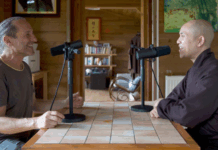By Jonathan Borella
The Buddha spoke of three doors of liberation: Signlessness, Aimlessness, and Emptiness. Often, these doors were taught as practices to engage practitioners in letting go of attachment to form, desire, and self. Other times, they were taught as descriptions of the true nature of reality. In either case, the three doors have profound implications on both the formal aspects of the practice as well as the way we formlessly manifest it in our daily lives.
As practitioners, we are encouraged to be determined in cultivating precepts, concentration, and insight – never letting our mind stray from mindfulness. In this way, we are able to walk through the three doors in every moment. But when we begin, we are certainly going to be confused about the three doors, especially when we notice the seemingly contradictory natures of Aimlessness and determination. How can we be both aimless and determined at the same time?
We shouldn’t run away from this confusion. In fact, if we are willing to step into it and rest in the state of not-knowing, then we are already practicing the Three Doors of Liberation. I remember when I first read about and began contemplating Aimlessness; I was afraid. I was afraid that without any aim, goal, or motivation I would have no reason to act. Why do anything at all? Why not be lazy, complacent, obedient…?
I let these questions dwell in my heart as I went about my daily life, bringing ever more mindfulness to the movements of body speech and mind. My practice of Aimlessness was still maturing but I had invited the practice into my being and was open to the possibility of one day being completely aimless. To my surprise, I found that my actions were becoming more determined, more intentional! I was making my bed in the morning. I was changing my diet. I was consuming with care. I was thoughtful in speech. Even opening a cupboard seemed to embody my full presence and intention. What was going on here!? I soon realized that I had no reason to fear falling into inaction.
Action is impermanence; and impermanence is life. It is impossible to do nothing. If I could really do nothing, then I could escape the law of impermanence. Try it right now. Try doing nothing. In this moment, you’re probably sitting, or maybe you’re standing or laying. You’re either breathing or holding your breath. Whatever you’re doing, you’re doing something. Every moment is a moment to act and as long as we have to act, we might as well decide how to act. When I realized this, my fear of doing nothing vanished and I could hold aimlessness and determination at the same time.
Think of it like shooting hoops. I like this analogy because it involves both a physical and psychological aspect of letting go. You calm your body and mind. All your presence and determination is focused on the task at hand. You throw the ball up, and then you let go. Once the ball is out of your hands it’s up in the air and no amount of aim or determination will change its course. This is the way we practice non-action – action that does not need to be reborn in the future but is complete in itself.
Perhaps the most confusing environment to practice Aimlessness is at work. As a behavioral therapist, my job is to help children with developmental disorders attain clearly defined goals aimed at appropriate social behavior. I often work with kids who behave aggressively towards others by hitting, spitting, and scratching. Sometimes we make progress, but there are always setbacks. If I were attached to or invested in constant progress; if my action were dependent on the attainment of goals, I could not continue. Yet, I go back day after day. On the outside it looks like determination. But really, is Aimlessness. Aimlessness is the only way to practice true determination.
To truly practice Aimlessness requires a degree of faith. I realized this while reading a passage in the New Testament. In the passage, Jesus is with his disciples when he points to a mountain and says that a person with enough faith could pray to God to move the mountain and the mountain will be moved. Here, my skepticism intruded. I knew that no matter how hard one prayed the only thing that would move that mountain is the shifting of tectonic plates. What was Jesus really trying to teach?
The answer lies in the nature of faith. Faith, as I understand Jesus to have taught, is surrendering to the will of God. So, praying for any particular object or outcome already demonstrates a lack of faith. I smiled when I realized Jesus was teaching his disciples Aimlessness. For Jesus, faith meant surrender to the will of God. For meditators, faith is letting go of attachment to outcomes and confidence in our practice. We know that whether or not the ball goes through the hoop, we can remain solid, free, and ready to get the rebound.


















Thanks, that is inspiring, I have been struggling with this aimlessness as well 🙂
Wonderful, I have not heard of aimlesslness prior to this. Loved the hoops analogy
Jonathan – Though I have come across such thinking in various reads, and you have explained it really well, I would like to quickly comment that the concept of Aimlessness (with determination) can be best described with the idea of attachment with proper understanding of detachment, which can be equated to Aimlessness while doing the Karma and being in the moment. We all need to learn the abilities to be unattached and that will help!
Dear brother/sister,
Thanks for this wonderful sharing. I have been struggling with aimlessness and working for quite some time and your experience has shed some lights and relieved me of some suffering. I am very grateful.